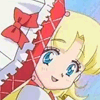| View previous topic :: View next topic |
| Author |
Message |
|
|
relyat08
 Joined: 20 Mar 2013
Joined: 20 Mar 2013
Posts: 4125
Location: Northern Virginia
|
 Posted: Mon Mar 12, 2018 11:15 am Posted: Mon Mar 12, 2018 11:15 am
|
 |
|
|
I certainly don't know why anyone would avoid a manga just because it is serialized in a demographic magazine they aren't part of, but I guess we're still not at a place socially where people feel at ease enjoying things that weren't targeted at their age group or gender.
When I watch something like Karakai Jouzu no Takagi-san, and see Takagi's crush be so embarrassed to be seen reading a shoujo romance manga that he lies pathetically about it, even though no one else cares, it's a little frustrating. Overall, I think it's getting better though.
|
| Back to top |
|
|
|
Coup d'État
 Joined: 29 Dec 2017
Joined: 29 Dec 2017
Posts: 179
|
 Posted: Mon Mar 12, 2018 11:19 am Posted: Mon Mar 12, 2018 11:19 am
|
 |
|
|
Yes, that's all there is. People who argue about which target group a series "really should be instead" drive me up the walls.
Tokyopop Germany often re-labels series into something else when they think something would sell better in that categories. For example, A Bride's Story' and is officially(wrongly) marketed Josei" in Germany, while 'Kasane' and 'The Miniature Garden of Twindle' are marketed as 'Shojo' and I want to scream.
I mean, people should freely read whatever they want, I sure do. I just don't get why some manga get the wrong label on purpose, if 'no label' would work just fine.
|
| Back to top |
|
|
|
|
Morry
Joined: 26 Jun 2016
Posts: 756
|
 Posted: Mon Mar 12, 2018 11:42 am Posted: Mon Mar 12, 2018 11:42 am
|
 |
|
|
Is it really that hard to just categorize things by genre? "Romance, adult, smut". "Action, fantasy, adventure, gore". There, now the boys and girls can decide if it's for them barring age restrictions.
|
| Back to top |
|
|
|
|
meruru
Joined: 16 Jun 2009
Posts: 475
|
 Posted: Mon Mar 12, 2018 11:54 am Posted: Mon Mar 12, 2018 11:54 am
|
 |
|
|
Although I would have categorized After the Rain as seinen knowing nothing about its official categorization by a. The artstyle b. How much furigana was is the original text (very little.) It just doesn't look like shoujo or josei at all.
|
| Back to top |
|
|
|
kawaiibunny3
 Joined: 10 Aug 2008
Joined: 10 Aug 2008
Posts: 534
Location: Houston, Texas
|
 Posted: Mon Mar 12, 2018 11:59 am Posted: Mon Mar 12, 2018 11:59 am
|
 |
|
|
The weirder thing to me is when a series is published in a younger demographic's magazine - but then the anime goes on to cater to adults.
Like the last time I flipped through a Nakayoshi magazine (typically for 8-12 year old girls) the original Sabagebu manga was being published. I thought it was an odd fit but saw how it could appeal to that demographic, then the anime got made and it was put on late at night and next to no merchandise was made for little girls, it was just the typical things that adult otaku buy.
Maybe that's just a more extreme case, but I definitely think that there's a rise in publishers mixing genres & demographics just to make anything that sticks.
|
| Back to top |
|
|
|
residentgrigo
 Joined: 23 Dec 2007
Joined: 23 Dec 2007
Posts: 2577
Location: Germany
|
 Posted: Mon Mar 12, 2018 12:02 pm Posted: Mon Mar 12, 2018 12:02 pm
|
 |
|
|
The system and the way books are being stocked is outdated but nothing will change any time soon. A Seinen magazine can´t run on gambling and violent action alone, so you put in a random cat manga and a romance manga and... The female demographic and their magazines have a bit of a stigma for just being the same old same old, which is mostly true, so such magazines don´t really deal in typical male manga. And good luck selling Josei manga to the masses, as even Justin used After the Rain as an example of a Shoujo "looking" anime. The Noitamina block that airs the show was also only supposed to be Josei too and it´s starting to drift into that direction again. I wonder how many will figure out that the upcoming Banana Fish is supposed to be Shoujo with it´s focus, on drugs, murder, (child)rape and Vietnam. The barely there Shonen-ai elements are about the only part that betray it´s roots.
A manga´s demographic can also change, as JoJo, Vinland Saga or Violence Jack (yes it was a kids book way back when) drifted up to Seinen. Honey and Clover or 7 Seeds went up to Josei. Gender jumps exist too but are rare. Organge by Orange Takano Ichigo went from Shoujo to Seinen after the publisher jump for example. Some manga can even be published in 2 conflicting magazines at the same time. These barely exist thought.
Web publications have stared to buck the trend of the 4 demographics but it will take at least a decade till these go anywhere. So the confusion shall continue till the print market is dead.
Last edited by residentgrigo on Mon Mar 12, 2018 12:06 pm; edited 1 time in total
|
| Back to top |
|
|
|
|
DRosencraft
Joined: 27 Apr 2010
Posts: 671
|
 Posted: Mon Mar 12, 2018 12:02 pm Posted: Mon Mar 12, 2018 12:02 pm
|
 |
|
|
I tend to agree with Morry; content categorization like Action, Drama, Fantasy, etc., tends to be the better sorting mechanic, even though it's not entirely perfect either. Again, going with the Prince of Tennis example, knowing it's labeled "sports" and "action" isn't really much different than labeling it "shounen" if your goal is to attract female readers/watchers. I've always felt like the "shounen," "shoujo," labels were more of the broad categories, and the labels like "action" and "supernatural" were like sub-categories. I guess the issue at the end of the day is that the shoujo, shounen, josei, seinen, categorization has become diluted to the point that it has a meaning that is too elastic. If the chosen categorization had firmer, nonvolatile, definitions that people could readily associate with the respective content, then you could rename them whatever you want and it would make sense.
It's easy to say, "just read a little to find out", but the categorization of a title helps narrow your search down for new stuff. No one has the time to read absolutely everything that comes out, so limiting that pool by eliminating works in categories you know you don't like helps a lot. Don't like historical fiction, then it'd be nice to know right of the bat that you're looking at a historical fiction title, instead of something generically labeled "shounen". Is it possible the person might actually turn out to like that work? Certainly. But if they already know they don't like historical fiction, the chances aren't that great. And if you still think they might, that's what reviews are for.
|
| Back to top |
|
|
|
rizuchan
 Joined: 11 Mar 2007
Joined: 11 Mar 2007
Posts: 980
Location: Kansas
|
 Posted: Mon Mar 12, 2018 12:11 pm Posted: Mon Mar 12, 2018 12:11 pm
|
 |
|
|
I find the distinctions less useful for action shows, but more useful for romance... There's a pretty big difference between shoujo romance and dating sim spin-offs.
Not that splitting romance shows into "for girls" or "for boys" is perfect, by any means. I remember seeing tons of guys on reddit getting wrapped up in Kimi ni Todoke or My Love Story and going "Why is this so different from most anime romance??" (Because it's shoujo), and an equal number of girls amazed that Clannad was written for guys. And then you have seinen romance which could resemble any of the above.
But, those problems seem more like exceptions than when I go, "I want to check out a new sappy romance anime," try to browse Funimation or wherever, and 95% of the "romance" category is just issekai shows with a harem element or fanservice shows.
|
| Back to top |
|
|
|
DerekL1963
 Subscriber
 Joined: 14 Jan 2015
Joined: 14 Jan 2015
Posts: 1120
Location: Puget Sound
|
 Posted: Mon Mar 12, 2018 12:12 pm Posted: Mon Mar 12, 2018 12:12 pm
|
 |
|
| relyat08 wrote: | | I certainly don't know why anyone would avoid a manga just because it is serialized in a demographic magazine they aren't part of |
You have to keep in mind the difference between how these series are published in Japan and how they're published in the west. Japan has a two-step process - first weekly or monthly in a magazine, followed by a tankobon if the series is popular enough. In the West, it's a single step - straight to tankobon.
Or, to put it another way, they're not avoiding a series serialized in a different demographic's magazine - it's that they're probably not buying the magazine in the first place. (They're avoiding the magazine, not the series.) And having not read the series as it was serialized, there's less incentive to buy the tankobon.
|
| Back to top |
|
|
|
|
Scalfin
Joined: 18 May 2008
Posts: 249
|
 Posted: Mon Mar 12, 2018 12:13 pm Posted: Mon Mar 12, 2018 12:13 pm
|
 |
|
| relyat08 wrote: | | I certainly don't know why anyone would avoid a manga just because it is serialized in a demographic magazine they aren't part of, but I guess we're still not at a place socially where people feel at ease enjoying things that weren't targeted at their age group or gender.
When I watch something like Karakai Jouzu no Takagi-san, and see Takagi's crush be so embarrassed to be seen reading a shoujo romance manga that he lies pathetically about it, even though no one else cares, it's a little frustrating. Overall, I think it's getting better though. |
I think a large part is that people who are choosing whether to read something haven't read it yet, and so use target to assess whether the work is targeting their sensibilities. It doesn't really matter how resonant a work is to the lives and concerns of pubescent girls if you're an aging man.
Overall, I think you can usually treat it as genre and tell by the influences and shows of author intent, although things can obviously get blurry in adaptation (whether it's adapting a subject genre to a different target-genre, as with shoujo sports, or adapting a manga made for one demo into an anime for the demo the manga actually became popular with, often with a change in art style and an increased emphasis on the homosocial bonds).
|
| Back to top |
|
|
|
|
Chrono1000
|
 Posted: Mon Mar 12, 2018 1:10 pm Posted: Mon Mar 12, 2018 1:10 pm
|
 |
|
Categorization of manga will always exist since a lot of manga are aimed at a certain demographic and include elements specifically for that demographic. The issue is that a growing number of shonen magazine include manga that are made for a shoujo demographic so the categorization is not as clear as it used to be. The idea that categorization is outdated since everything has to be made for everyone is not realistic since generally speaking men and women have different preferences especially in regards to ecchi manga.
| relyat08 wrote: | | I certainly don't know why anyone would avoid a manga just because it is serialized in a demographic magazine they aren't part of, but I guess we're still not at a place socially where people feel at ease enjoying things that weren't targeted at their age group or gender. |
Most people will read/watch something if they like it but whether they let other people know about it does depend on social stigma.
|
| Back to top |
|
|
|
|
katscradle
Joined: 05 Jan 2013
Posts: 469
|
 Posted: Mon Mar 12, 2018 1:32 pm Posted: Mon Mar 12, 2018 1:32 pm
|
 |
|
|
Yep. I always look at the magazine. Though, sometimes that’s not even easy because you have kinda grey, borderline, mixed magazines too. Sometimes titles make jumps across magazines. Then yes when something is taken overseas it can be marketed in a different way. Once heard a person at a publisher say if it’s about adults it’s for adults. Problem is there are such titles intended for teenagers that they will perfectly appreciate and vice versa. I’ve seen series aimed at girls put under boys’ labels because it was bloody or more action oriented. Critics recommending a title by a woman aimed at men but, because it’s by a woman think it should appeal to women…
I wish we could just use regular genre categories. I’ve always told people read whatever they want because it’s just a target and the point is to enjoy yourself. I know people who are big fans of things outside the demographic they fit into. When I was younger I used to consume stuff from pretty much any category. So would it really be super hard if you’re looking for say a fantasy story to find one that has what you’re looking for without knowing it’s from a certain demographic?
Sometimes people are suspicious or act like there was editorial interference because of the category when they find something they just don’t like in a certain title too. Except that’s not always the case. As is pointed out, some artists work across demographics and in a lot of genres making both lighter and more serious stuff. But it’s easier for fans to blame the big bad corporate powers than feel disappointed in an artist.
Honestly, it bugs me sometimes people miscategorize though. One example is Fumi Yoshinaga’s Antique Bakery and What Did You Eat Yesterday. I know they appeal to some BL fans or LBGTQ people but, one ran in a female oriented magazine that’s rather borderline and the other runs in a men’s magazine. She’s even pointed out Antique Bakery is not a BL before. Of course the only reason the category matters so much is negative associations with genre. So why can’t someone categorize them as foodie or dramedy comics?
Kind of related comics need to be treated like other books too if the goal is reaching a larger audience.
|
| Back to top |
|
|
|
|
Gemnist
Joined: 10 Feb 2016
Posts: 1761
|
 Posted: Mon Mar 12, 2018 1:32 pm Posted: Mon Mar 12, 2018 1:32 pm
|
 |
|
|
I've always found the line to be incredibly blurry and messed up, given that seinen-esque series like Death Note, Attack on Titan The Promised Neverland frequently appear in different demographic magazines. I mean, if I told you that the manga adaptation of Cowboy Bebop was published in a shojo magazine, would you believe me? Of course not - because it's constructed like a seinen. Honestly, what magazine it's published in should not factor in to one's decision-making, especially in the case of tankobon. It only really should when the shonen label is taken as a genre (as with most action-oriented WSJ series).
|
| Back to top |
|
|
|
Compelled to Reply
 Joined: 14 Jan 2017
Joined: 14 Jan 2017
Posts: 358
|
 Posted: Mon Mar 12, 2018 1:50 pm Posted: Mon Mar 12, 2018 1:50 pm
|
 |
|
| relyat08 wrote: | | When I watch something like Karakai Jouzu no Takagi-san, and see Takagi's crush be so embarrassed to be seen reading a shoujo romance manga that he lies pathetically about it, even though no one else cares, it's a little frustrating. Overall, I think it's getting better though. |
You're frustrated over Takagi teasing Nishikata because he likes a fictional stereotypical shojo series "100% Unrequited Love?" That proves demographic division because Takagi-san is shonen, aimed at boys Nishikata's age who are best able to relate to him. Still, do you remember ever being teased for liking something when you were his age? For example, liking Pokémon in middle school and getting teased or even bullied over it, but by high school, is more acceptable because associated nostalgia attached to it. Also, it also explains how series we might consider shonen are actually seinen. If you ask a teenager whether a series is shonen or seinen, they're more discerning from reasons like psychology, age, and development stage, compared to old and dulled otaku like us.
|
| Back to top |
|
|
|
Jonny Mendes
 Joined: 17 Oct 2014
Joined: 17 Oct 2014
Posts: 997
Location: Europe
|
 Posted: Mon Mar 12, 2018 2:16 pm Posted: Mon Mar 12, 2018 2:16 pm
|
 |
|
| Gemnist wrote: | | I've always found the line to be incredibly blurry and messed up, given that seinen-esque series like Death Note, Attack on Titan The Promised Neverland frequently appear in different demographic magazines. I mean, if I told you that the manga adaptation of Cowboy Bebop was published in a shojo magazine, would you believe me? Of course not - because it's constructed like a seinen. Honestly, what magazine it's published in should not factor in to one's decision-making, especially in the case of tankobon. It only really should when the shonen label is taken as a genre (as with most action-oriented WSJ series). |
The reason is that in Japan the notion of age group is also blurry. Unlike the west were there is a definitive separation of age moments in a person life (baby, child, adolescent, adult, old age) in Japan life is mostly viewed as a continuum from birth to dead.
Age can be defined in legal terms, like legal age of drink, marriage, drive, and in case of manga/anime there are restrictions on age of adult R-18 manga/anime but the separation of childhood, adolescence, adult etc is very blurry.
|
| Back to top |
|
|
|
|
 Subscriber
Subscriber